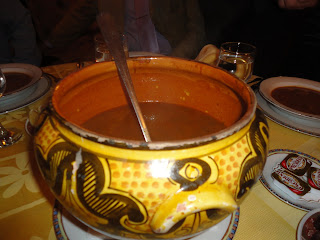While in Morocco, Teachers for Global Classroom participants were engaged in three primary goals. One goal was to study the structure of the Moroccan school system. We had general introduction while in conferences in Rabat and then we were assigned in groups of two or three to travel to various parts of Morocco to look closely at a school and the teaching there.
I was fortunate enough to travel with an ESL and social studies teacher named Bruce. He's from Tacoma, Washington. We were hosted by an amazing English as a Foreign Language teacher named Mifdal Bouchaib and were stationed in his home school of Lycee Ibn Khaldoun.

Lycee Ibn Khaldoun is located in a nice neighborhood in El Jadida. The streets there are clean and lines with well kept walls and gardens. Like many of the cities along the Atlantic coast the buildings tend to be painted white although a few are the deep terra cotta red typical of Marrakesh. As you can see, the school is painted in soft pinks and terra cotta red.


Morocco is an amazing place for anyone interested in learning about language acquisition. I was amazed by the level of English language proficiency Mifdal's students after less than one year of study. They were able to discuss most issues of interest to them and to respond to my questions.
Why do students in Morocco display such aptitude for language learning?
I think that there are several factors and each require more depth of study than I can devote in this blog today.
Morocco has been a crossroads of cultures and language for as long as there have been people there. The first group known to inhabit the area are called the Amazigh (more commonly known as the Berbers). The Amazigh inhabit primarily the Atlas and Riff mountain ranges. They met the Phoenecians, Cathaginians, Romans, Arabs, French, Spanish and Portuguese during the course of their history and development. (If I am neglecting a group, please forgive me). A few of these various groups left an indelible mark on the increasingly ethnically diverse people of Morocco. Of course, the arabs brought with them language, religion and cultural influence. The period of European colonialism left it's mark with Spanish speaking enclaves in the north and south. The long period of French colonialism left the Moroccans with French. In the end, the Moroccan people retain a pride in the understanding that they are a cultivated bridge between the Christian west and Islamic east.
Morocco now enjoys three official languages, French, Arabic and Amazigh. Amazingly, they each have their own alphabet.
Check these out!

Lycee Ibn Khaldoun is located in a nice neighborhood in El Jadida. The streets there are clean and lines with well kept walls and gardens. Like many of the cities along the Atlantic coast the buildings tend to be painted white although a few are the deep terra cotta red typical of Marrakesh. As you can see, the school is painted in soft pinks and terra cotta red.


Morocco is an amazing place for anyone interested in learning about language acquisition. I was amazed by the level of English language proficiency Mifdal's students after less than one year of study. They were able to discuss most issues of interest to them and to respond to my questions.
Why do students in Morocco display such aptitude for language learning?
I think that there are several factors and each require more depth of study than I can devote in this blog today.
- Cultural History and Development
- Worldview and Moroccan Cultural Identity
- Curriculum Design
Morocco has been a crossroads of cultures and language for as long as there have been people there. The first group known to inhabit the area are called the Amazigh (more commonly known as the Berbers). The Amazigh inhabit primarily the Atlas and Riff mountain ranges. They met the Phoenecians, Cathaginians, Romans, Arabs, French, Spanish and Portuguese during the course of their history and development. (If I am neglecting a group, please forgive me). A few of these various groups left an indelible mark on the increasingly ethnically diverse people of Morocco. Of course, the arabs brought with them language, religion and cultural influence. The period of European colonialism left it's mark with Spanish speaking enclaves in the north and south. The long period of French colonialism left the Moroccans with French. In the end, the Moroccan people retain a pride in the understanding that they are a cultivated bridge between the Christian west and Islamic east.
Morocco now enjoys three official languages, French, Arabic and Amazigh. Amazingly, they each have their own alphabet.
Check these out!

















